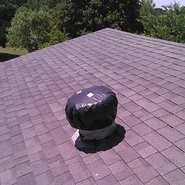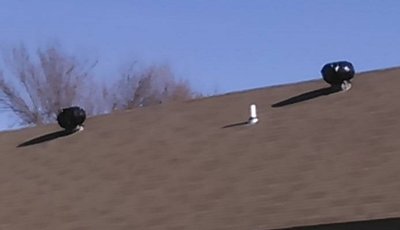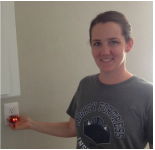I noticed this home the other day. It’s not uncommon for people to cover attic vents on the roof, but it’s a bad idea. And here’s why.
The myth behind covering vents is that if you trap heat in the attic, you will increase the energy efficiency of the home during the winter months. Since heat rises, if you trap it from escaping the top of your house, your house stays warmer, right? While this seems somewhat logical, building science proves it wrong. The fact is that attics should be ventilated year round.
Side note: There are some attics with spray foam insulation that are not ventilated, and should not be ventilated. But that is entirely another topic, so for now we will focus on homes that have ventilated attics.
There are two primary reasons for attic ventilation: to allow for heat to get out of the space, and to allow moisture to escape. Ventilation is complicated and has to be calculated based on the square footage of attic space present. There are many homes in Oklahoma that are not properly ventilated.
An attic should have a change in air flow, or be able to "breathe". Ventilation should be 50% from the soffit or intake and 50% exhaust at the peak of the roof. This allows heat to escape in the summer months and reduce shingle wear. The Oklahoma sun is brutal on the top side of shingles, but if the attic isn’t properly ventilated then that heat is doubled from the inside, causing even more damage to a roof. I have seen many roofs worn out prematurely from improper attic ventilation.
During the winter months the heat isn’t as bad, but there can be moisture present in the attic space, and this moisture needs a means of escape. This is especially true if bathroom exhaust fans are not vented to the outside. Point of fact, they should be; but I frequently inspect homes where this is not the case. Trapped moisture can condense on the insulation, and once insulation is wet it no longer insulates. So adding those vent covers can actually make your home less energy efficient! Also, heavy moisture inside an attic can grow mold, which can compromise the indoor air quality of the home.
Side note: There are some attics with spray foam insulation that are not ventilated, and should not be ventilated. But that is entirely another topic, so for now we will focus on homes that have ventilated attics.
There are two primary reasons for attic ventilation: to allow for heat to get out of the space, and to allow moisture to escape. Ventilation is complicated and has to be calculated based on the square footage of attic space present. There are many homes in Oklahoma that are not properly ventilated.
An attic should have a change in air flow, or be able to "breathe". Ventilation should be 50% from the soffit or intake and 50% exhaust at the peak of the roof. This allows heat to escape in the summer months and reduce shingle wear. The Oklahoma sun is brutal on the top side of shingles, but if the attic isn’t properly ventilated then that heat is doubled from the inside, causing even more damage to a roof. I have seen many roofs worn out prematurely from improper attic ventilation.
During the winter months the heat isn’t as bad, but there can be moisture present in the attic space, and this moisture needs a means of escape. This is especially true if bathroom exhaust fans are not vented to the outside. Point of fact, they should be; but I frequently inspect homes where this is not the case. Trapped moisture can condense on the insulation, and once insulation is wet it no longer insulates. So adding those vent covers can actually make your home less energy efficient! Also, heavy moisture inside an attic can grow mold, which can compromise the indoor air quality of the home.

Another problem with covering vents in the winter months is that Oklahoma weather can be a little on the crazy side. It may be 70° on a January day and then the next day it is in the 30’s. If you are covering your vents, there could be excess heat building up on those warm days, and excess moisture on the cold ones.
Also, it is somewhat dangerous to climb on a roof to install the cover. Because people are not the most comfortable on top of their homes, those covers are often left on well into the spring and summer months where temperatures can get very warm. And like Christmas lights, some people just leave the vent covers on all year, which is really a bad idea!
If you are interested in saving money on energy bills look into better insulation for your attic space, tune up your furnace, and even consider bumping down that thermostat a degree or two. If you do look into adding insulation in your attic, make sure your soffit vents have baffles installed and are not covered up. Remember we want 50% intake as part of a well ventilated attic.
Finally, if you are going to have your roof redone, make sure you talk to your roofer about proper ventilation. It may be that your roof was not properly ventilated in the first place, and many times the ventilation is just copied when the new shingles are put on. Making sure the ventilation is appropriate will help to prolong the life of your new roof. Provided hail and tornadoes aren’t a problem!
There are many factors to ventilation; this just scratches the surface. Our goal for today was to prevent the covering of roof vents, we’ll tackle additional concerns another day. But for now take an easy breath and be mindful of attic ventilation!
Also, it is somewhat dangerous to climb on a roof to install the cover. Because people are not the most comfortable on top of their homes, those covers are often left on well into the spring and summer months where temperatures can get very warm. And like Christmas lights, some people just leave the vent covers on all year, which is really a bad idea!
If you are interested in saving money on energy bills look into better insulation for your attic space, tune up your furnace, and even consider bumping down that thermostat a degree or two. If you do look into adding insulation in your attic, make sure your soffit vents have baffles installed and are not covered up. Remember we want 50% intake as part of a well ventilated attic.
Finally, if you are going to have your roof redone, make sure you talk to your roofer about proper ventilation. It may be that your roof was not properly ventilated in the first place, and many times the ventilation is just copied when the new shingles are put on. Making sure the ventilation is appropriate will help to prolong the life of your new roof. Provided hail and tornadoes aren’t a problem!
There are many factors to ventilation; this just scratches the surface. Our goal for today was to prevent the covering of roof vents, we’ll tackle additional concerns another day. But for now take an easy breath and be mindful of attic ventilation!


 RSS Feed
RSS Feed